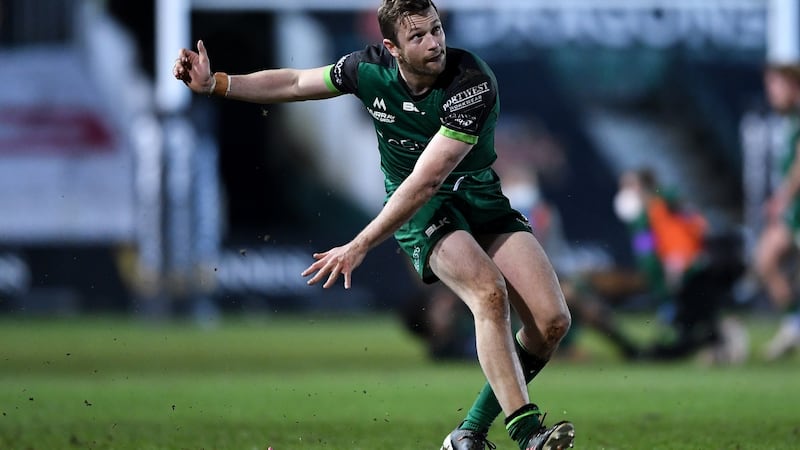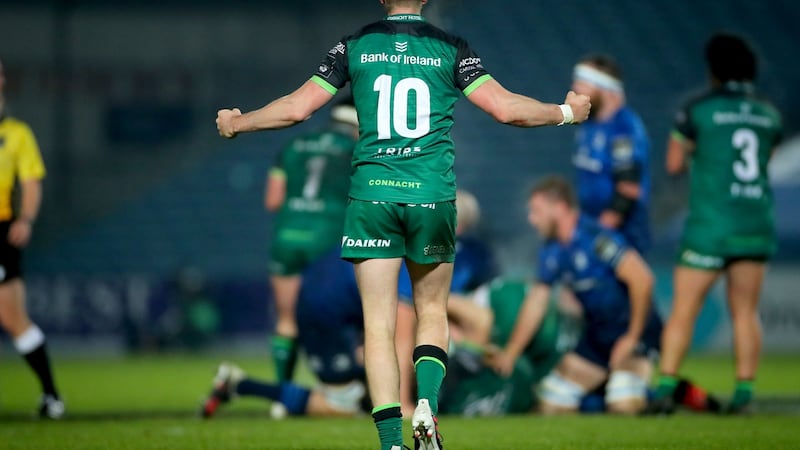Jack Carty
Age: 28.
School: Marist College, Athlone.
Club: Buccaneers.
Carty, who also played soccer for the Republic of Ireland at under-15 level and minor football for the Roscommon minors, made his debut for Connacht in September 2012.
He has played 150 times for the province, and is Connacht's all-time leading points' scorer with 870. Carty has also played 10 times for Ireland, all in 2019, but the last of those was against Russia in the 2019 Rugby World Cup.
Out of contract at the end of the season, a couple of Top 14 clubs are believed to have made entreaties to sign him (including Clermont), but an announcement confirming that he has signed a new one-year deal is expected to be confirmed by the province shortly.
***
Joey Carbery has been described as the forgotten man of Irish rugby but that's hardly true. Munster and Irish rugby pines for the return of the innately gifted and classy 23-year-old, and scrutinises his gradual return to action with fingers crossed. Everyone wishes the heir to the 10 throne a complete and sustained recovery.
Meanwhile though, there is an Irish outhalf who is first-choice for his province, with whom he has now played 150 games. He’s also their main goal-kicker, at 28 he should be at or nearing the peak of his powers and is, according to his coach, playing better than ever.
If anybody is the forgotten outhalf it is Jack Carty.
He played in 10 of Ireland’s 14 tests in 2019, even if just two of them were from the start - the World Cup warm-up win over Wales in Cardiff and the pool defeat by Japan.
After a decent first half, during which he was the chief creator of Ireland’s two tries, his performance subsided like many others in the second half in Shizuoka before he was taken off after missing a couple of tackles. It seems as if he has dirtied his bib beyond repair since that day, and after playing the second half of the pool win over Russia he hasn’t been seen since.
Carty was evidently scarred by his World Cup experience too, and subsequently even lost his starting place at Connacht but he looked back to himself when rugby returned at the end of August.
His treatment since has been puzzling. Called into the Irish squad for the rescheduled Six Nations games against Italy and France, he wasn't picked in the 23 for either game and was then dropped from the wider squad for the Autumn Nations Cup altogether.
Carty’s contract expires at the end of this season and French sources indicate there had been firm interest from Clermont and possibly another Top 14 club, as well as one from the Premiership but, despite that, he is expected to stay on with Connacht.
Crude yardstick
Clearly, Carty still believes that he can break back into the Irish team.
In the meantime, two rounds into the Six Nations what have we learned about the vexed number 10 jersey? That Johnny Sexton is still comfortably the best outhalf in Ireland, but then that was never really in doubt.

Since the start of the 2017-18 season, with Sexton starting at 10 Ireland have won 21 matches and lost six, equating to a winning ratio of 78% per cent. In the 10 games he hasn’t started, Ireland have won five and lost five. It’s a crude yardstick, but to further place the five wins in context, they came against Italy (twice), the USA, Wales in a warm-up game and Georgia.
"I think we are struggling at 10 to be brutally honest," Brian O'Driscoll informed Off the Ball listeners earlier this week.
“It’s not just their problem, it’s the quality of possession but I just feel as though the gulf is so considerable from Johnny Sexton to the next player. I actually think at this stage it’s worthwhile giving Jack Carty another go.
“He probably presents a little bit more from an attacking mindset point of view. He goes to the line quite aggressively, he’s very capable of running with the ball himself. I don’t think he does it quite as well as Johnny Sexton but he definitely takes a step, he hits the pass a little bit more than the two boys at the weekend and maybe it’s time to see if he deserves that second shot at it and maybe he can be the one to bring us forward over the next year.”
As he also noted, Andy Farrell was part of the Irish coaching ticket when Carty was at the helm for the defeat by Japan. "It takes a huge amount of positives to balance the journal, and brilliant individual and collective team performances to get yourself back in the reckoning."
For sure, had Connacht completed an astonishing comeback at Racing 92 then Carty's performance in the win over Leinster at the RDS when he scored a record-equalling 25 points might have been harder to overlook.
To some degree, no less than scapegoating Carty for the events in Shizuoka, passing definitive verdicts on Billy Burns and Ross Byrne are a little unfair. After all, the three share one common thing; they have now each started just two tests apiece.
Unlike Byrne and Carty, Burns is not first-choice goal-kicker for his province, as O'Gara noted beforehand prophetically. Indeed, it had shades of 2013, when Declan Kidney propelled the then 21-year-old Paddy Jackson into the number 10 jersey in ending O'Gara's Test career. Ironically, whereas John Cooney is currently first-choice kicker for Ulster, back then it was Ruan Pienaar.
Although his game was good, Jackson kicked one out of four on his debut in a 12-8 defeat at Murrayfield, and three from five in a 13-all draw with France before kicking five from six in the defeat by Italy in Rome.
Last week, Burns steered his first penalty well wide before landing an easier one soon after but, by contrast, Ross Byrne landed his two clutch kicks, taking on a 45-metre penalty without seeming to so much as consult Iain Henderson. That was ballsy.
Indeed, in that tortuous last play, the French replacement hooker Pierre Bourgarit came half-way up an Irish ruck, although having blithely ignored the hindmost line all day long the English officials weren't going to start then. Gregory Alldritt also seemed to make a no-arms tackle on Ultan Dillane. The point being that you'd have placed a considerable wager on Byrne nailing the kick.
It would have been some steal, too. Daylight robbery even.
Gameplan
Perhaps, in hindsight, Byrne might have been the better bet to start with Burns off the bench, especially given the gameplan was clearly based on kicking from anywhere outside the French 10 metre line, and once even within.
Barely a minute in, when Rhys Ruddock and Tadhg Beirne manufactured a steal on the French throw on the visitors' 10 metre line, Burns unhesitatingly kicked the ball skyward with a clear four-on-three or three-on-two and more than half the pitch's width to play with.

Whether Robbie Henshaw, Garry Ringrose or Keith Earls called for the pass, you know O'Driscoll would have, and Sexton probably wouldn't have needed the call. With 92 Test starts, he also would have had the experience and strength of personality to do so too.
Part of the new Farrell way has been to liberate ‘heads up rugby’, and on Thursday he seemingly had this second minute example in mind when saying: “What is that? It’s not complicated. If you get a ball that’s on (the) halfway line and you’ve got 40 metres of space on the right-hand side, are you going to run, pass or kick? Those decisions have always been in the game.”
Yet Burns, perhaps nervous after the Cardiff endgame, was clearly playing with the game plan in his ears.
Barely a minute later, from a scrum just outside the French 10 metre line, Ireland went through four phases before Jamison Gibson-Park launched an up-and-under 40 metres from the French posts. Leading the chase? Andrew Porter. There were more up-and-unders 40 metres or so out from Burns after a second lineout steal and from off the top lineout ball.
Ireland have been proficient at winning turnovers, be it off the opposition throw, in the tackle and at rucks. But they have made little use of them, almost as if they don’t train to transition from defence to attack.
O’Driscoll says he feels for Ringrose, who is being shovelled on ball in a static backline and left to create for himself in the wider channels, and the same is true for Earls, when he’s not chasing bombs.
There were other opportunities to find space on the edges.
A striking feature of the French defensive system is how Antoine Dupont is their 'shooter', à la Jamie Heaslip under the Les Kiss' system in the 2009 Grand Slam.
In the 35th minute, after Ireland worked two rucks in the middle of the pitch off a lineout, Henshaw pulled the ball back for Burns. As Dupont shot up on Hugo Keenan, Burns passed to the full-back, and was obliged to veer inside into the blue wall. Sexton would assuredly have seen and executed the skip pass to Earls in clear space.
Early in the second-half off an Irish scrum on their own 10 metre line, Gibson-Park and Keenan broke to the right, with Earls on the wing. CJ Stander passed left off the base straight to Byrne, who had the centres and James Lowe to his left in a four-on-four. Byrne pivoted and skip passed to Ringrose, who ran diagonally as the French defence drifted on to him and, with the space shrinking, his attempted switch with Lowe ended with a supposed knock-on when tackled.
Kicking tactics
We’ve seen Ireland do that play, or versions of it, on many occasions and every time Sexton has run hard and straight for three or four strides to engage the defence and so create more space for those outside.
When Byrne came on, with Ireland needing at least one try if they were to win, he eschewed the kicking tactics, but straight after the game and again on Thursday, Farrell lamented the game management by trying to “chase the game”.
So although Ireland had 41 kicks in play (France had 32) with Gibson-Park (14) and James Lowe (13) leading the way, the impression conveyed is that they should have kicked more.
People may complain about Sexton's tackling technique but, akin to Conor Murray being Ireland's best defending scrumhalf, he's the best defending 10. In the same way he'll take a shot on the gain line when carrying, à la Jonny Wilkinson and Owen Farrell, he's one of those rare outhalves who seems almost to relishes tackling.
As Gordon D'Arcy writes, Gaël Fickou carried a good five metres over the gain line when going through Burns in the starter play for the Charles Ollivon try. Similarly, Alldritt and Fickou powered over the gain line when running at Burns and Byrne in the build-up to Dupont unusually butchering a try after the interval and the Damian Penaud try.
As with tighthead, Ireland have been spoiled by not only having two brilliant outhalves in O’Gara and Sexton, but two such durable ones as well. Between them, they have started 80 of Ireland’s last 87 Six Nations games.
As O’Driscoll put it: “For all the people calling on Johnny Sexton to be culled, and he’s past his best, his best is still considerably the best in Ireland….by a long shot.”













